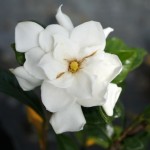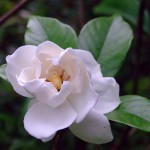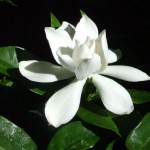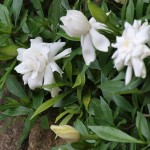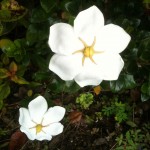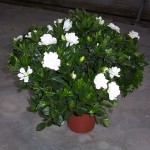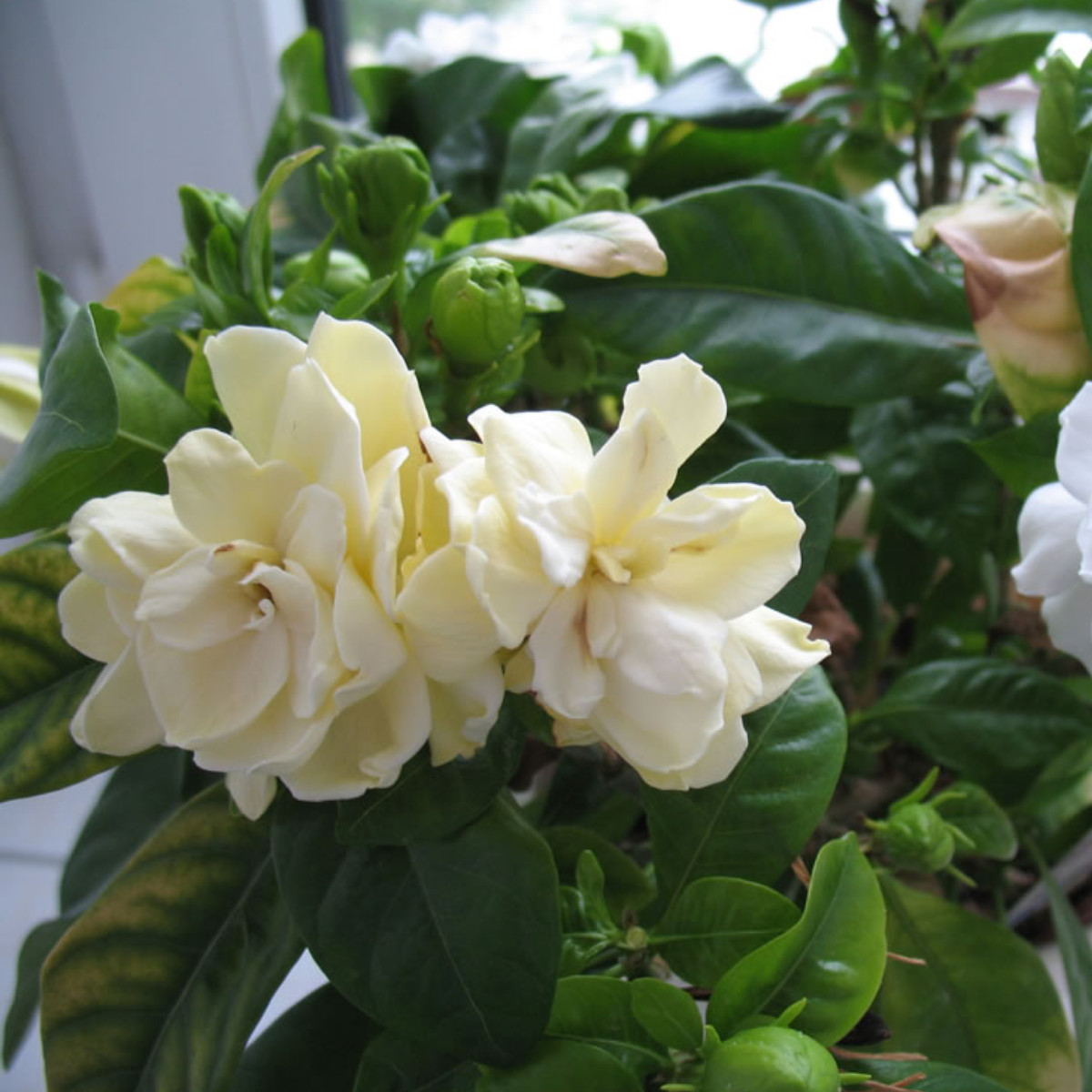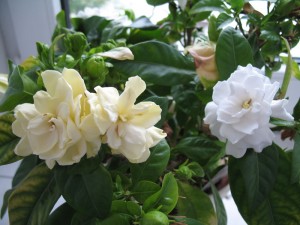Family: Rubiaceae
Synonymous: Gardenia augusta
Genipa florida
Genipa grandiflora
Genipa radicans
Distribution and habitat: Gardenia jasminoides is an evergreen flowering plant originated in Asia. It is most commonly found growing wild in Vietnam, Southern China, Taiwan, Japan, Myanmar and India distributed in broad-leaved forests at low to medium elevations. With its shiny green leaves and heavily fragrant white summer flowers, it is widely used in gardens in warm temperate and subtropical climates and as a houseplant in temperate regions.
Description: Gardenia jasminoides are low-growing bushy shrubs mainly prized for their fragrant flowers which give out a heady perfume. Gardenia jasminoides is the only species of Gardenia grown indoors. Despite their common name 'Cape Jasmine' they are not related with true Jasmine. As a potted plants rarely exceeds 45cm (18 inch) in height or spread, even through it is capable of growing up to 2m (7 feet) in climates where it can be grown outside in the garden.
The 10cm (4 inch) long leaves of Gardenia jasminoides are shinny, dark green, leathery, lance-shaped and usually arranged in opposite pairs, though sometimes in whorls of three or more. The flowers, which may be fully double (with many petals or semi-double with only two layers of slightly arching petals), are 5-10cm (2-4 inch) across and appear, usually singly, from leaf axils near the ends of the shoots.
Most Gardenia jasminoides bloom naturally during the summer months. Each flower may last only five to seven days, but the bloom can last for many months with proper care. Only a few flowers are generally open at any given time per plant. Happy plants may bloom a second time in the fall.
The plants can live up to 10 years, indoors, with proper care.
Houseplant care: Gardenia jasminoides are not difficult plants to grow, although they require particular attention in order to flower.
Some early spring pruning is usually necessary to keep the shrub low and bushy. Nip out the growing points of any long new shoot on young plants and cut out about half or even two-thirds of the old wood of the mature plants. Be careful, however, not to nip out flower buds. The stems of the plants can always be cut back later after the flowers have died. The cuts should be made immediately above the points where growth-producing duds point outward rather than toward the centre of the plant.
Remove the faded blooms.
Natural gas fumes will harm the plant, so growing gardenias near a gas stove or fireplace is not a good idea.
Light: Gardenia jasminoides do best in bright light. Always keep them out of direct sunlight, however.
Established plants may be moved outdoors in a shady, sheltered location for the summer months. Bring the plant indoors when temperatures fall bellow 15C (60F).
Temperature: The key to success in bringing Gardenia jasminoides into flower is to maintain a steady temperature of 16-17C (61-62F) during the period when flower buds are forming; a sudden change in either direction is practically certain to cause the buds to drop off. When plants are not forming flower buds, the range can be that of fairly normal room, between 15-24C (60-75F).
A high degree of humidity is also essential when flower buds are forming. To achieve this, stand the pots on trays of moist pebbles or peat moss and spray plants at least once a day with fine mist-spray, using water at room temperature. But try not to wet the flowers if the plants are in bloom, because water on the petals causes discolouration.
Fresh, moist (humid) circulating air is a necessity, especially during the winter. Hot, stale or dry air can cause fungal issues. Keep this plant away from radiators and avoid draughts.
Watering: Gardenia jasminoides do not have a well defined rest period. They grow less actively, though, during the winter in areas where the winter months bring on considerable reduction of light. In such places water these plants moderately during the summer, giving enough at each watering to make the potting mixture moist throughout and allowing the top centimetre or so of the potting mixture to dry out before watering again. During the winter months allow the top few centimetre or so of the potting mixture to dry out completely before watering again.
Such reduced winter watering is desirable even with the plants that are forced into winter flowering. In areas with less winter reduction of light, watering can remain unchanged throughout the year. Always use slightly warm, preferable lime free water for these plants.
These flowering plants are thirsty. Dry soil will cause the buds to drop. Check the soil at least every couple days. Keep it moist but not soggy, which can also cause buds to drop.
Feeding: Apply an acid fertiliser every two weeks, but only during the growing season, to these lime heating Gardenia jasminoides plants.
Potting and repotting: Most growers use a lime free potting mixture even though Gardenia jasminoides can tolerate a little alkalinity. A mixture of equal parts of leaf mould and peat moss is excellent. If a propetary peat-based potting mixture is used, make sure it is suitable for lime hating plants, since some are not. Because there is relatively little nutritional value in leaf mould and none in peat moss, it is especially important to give a regular feeding as recommended if this mixture is used. It is also possible to use a soil based potting mixture as long as it is non-alkaline. The feeding regime is less essential with soil based potting mixture than with soil-less ones.
Repot Gardenia jasminoides only when their roots have nearly filled the pot (as indicated by their appearance at the surface or outside the bottom drainage holes). These plants flower best when they are kept in pots that are just a little too small for vigorous stem growth. Ideally, any repotting should only be done when the plants are beginning to grow in the spring and the root ball should be disturbed as little as possible.
Gardening: Gardenia jasminoides can be grown in beds in areas within its hardiness zones, but growing them in containers allow the plants to be moved to more suitable seasonal sites and makes it easier to control pests.
When pulling weeds from around Gardenia jasminoides in garden, do so carefully. This plant's roots are shallow and can damage easily. Consider to place a 5 to 8cm (2-3 inch) layer of organic mulch to keep the weeds from growing as it helps the soil to maintain moisture.
Location: Gardenia jasminoides can grow in part shade or part sun. It requires good amount of light to bloom successfully. During the hottest climate, protect the plant by keeping it in shade. Although, keep away from big bushy shrubs which can overwhelm this smaller Gardenia jasminoides.
The fragrance of Gardenia jasminoides plants is strong, so it is best planted in a place where its smell can spread easily. It can be planted near a wall, deck or patio; so that its fragrance is carried easily throughout the landscape.
Soil: The preferred soil for Gardenia jasminoides should be rich, acidic, moisture-retentive and well drained. Use a soil which has 6 or higher pH. This is a calcifuge (lime hating) plant, which means it does not tolerate alkaline soil. If the soil is not acidic enough, then many plant problems can occur.
When planting them, keep a distance of at least 1m (40 inch) between each plant.
Irrigation: Gardenia jasminoides requires average watering. However, supply the plant adequate water on a regular basis, taking care not to over water it. The soil should be kept moist at all times, but it should not be soggy. Irrigating with drip systems keeps water off the foliage and flowers, which helps prevent leaf and petal spots. When well established, it can moderately tolerate drought conditions. To help maintain adequate soil moisture, use mulch and avoid cultivation around the base of the plant.
Avoid using very hard water for Gardenia jasminoides, however. If soft water is not available, then add some vinegar to the hard water to lower its pH.
Fertilise:Gardenia jasminoides requires fertilisation twice in a year to maintain dark green leaves. Fertilise during early spring (before the flowers appear) and during early summer. Use an iron chelate fertilizer and mix with an acidic soil mixture.
Propagation: Gardenia jasminoides can be propagated from 8cm (3 inch) long tip cuttings taken in early spring. Dip these in hormone rooting powder and plant them in small pots of moistened peat-based potting mixture suitable for lime hating plants. Place the potted cuttings in a heated propagating case or alternatively, enclose them in a plastic bags and keep them at a temperature of 15-18C (59-64F) in bright light which is filtered through something like a translucent blind or curtain. Rooting should occur in four to six weeks. In late summer move the rooted cuttings into pots a size larger, containing the potting mixture recommended for mature plants. Water them moderately and feed them at least once a month until they are well developed. Then treat them as mature plants.
Recommended varieties:
Gardenia jasminoides 'Belmont' which is densely bushy plant and bears large, fragrant, many petaled, white flowers that turn cream coloured as they age. This variety is often sold as cut flowers by florists.
Gardenia jasminoides 'Fortuniana' (Gardenia jasminoides 'Florida') is a less bushy plant with medium size, rather waxy, snowy-white, many petaled flowers that turn yellowish with age.
Gardenia jasminoides 'Veitchii' has a dense growth and medium size, many petaled flowers which normally remain pure white. This variety can be brought into flower in early winter by dis-budding (having their flower buds picked off at an early stage) throughout summer and early autumn.
Gardenia jasminoides 'White Gem' is a dwarf variety reaching only 60cm (24 inch) tall. It is one of the most common species of Gardenia for growing indoors.
Gardenia jasminoides 'Radicans' has an upright form, making it a favorite for shaping a gardenia tree. It is perfect for creating a Gardenia bonsai.
Problems: Generally the result of incorrect treatment.
Yellowing leaves are the result of careless watering or due to deficiency of one or more micro nutrients (usually iron).
Treatment: Allow the soil to remain evenly moist but not water saturated. Micro nutrients deficiency can often be corrected by acidifying the soil with aluminum sulfate, iron sulfate or wettable sulfur. Iron chelate may be used on the soil or foliage. An acidulating houseplant fertilizer can be used to lower soil pH.
Bud drop may be caused by sudden changes in temperature or by incorrect watering.
Treatment: Maintain adequate soil moisture but avoid over-watering; avoid insufficient light; avoid planting in locations where nighttime temperatures commonly exceed 13-15C (5560F); control parasitic insects.
Failure of flower buds to form is a result of too high temperatures (day and/or night) as well as too low temperatures at night.
Red spider mite andaphids may be a problem where the humidity is low. These insects are small and often hide underneath the leaves. Symptoms are: the leaves are turning yellow, curling or there are holes in the leaves.
Treatment: Spray the plant with insecticidal soap. Follow the label directions for proper usage.
Whiteflies are white and cottony appearance of leaf undersides. The whiteflies have as a side effect accumulation of black sooty mold.
Treatment: Successive sprays of insecticidal soaps or white oil.
Treatment: Successive sprays of insecticidal soaps or white oil.
Thrips are tiny black insects that feed on flowers and leaf undersides. They cause browning the margins of the flower petal, distortion of flowers or failure of buds to open.
Treatment: Treat the plant with a suitable insecticide, but it should be used while the flowers are still in bud, because it can burn the petals.
Treatment: Treat the plant with a suitable insecticide, but it should be used while the flowers are still in bud, because it can burn the petals.
Mealybugs suck plant juices, and heavy infestations will coat the leaves with sticky honeydew. They appear as white cottony masses found in the leaf axils, underside of leaves and other protected areas.
Treatment: Use appropriate insecticides. Remove with an alcohol saturated cotton swab or wash plants with soapy water and a soft brush or cloth or pick off with tweezers or a toothpick.
Treatment: Use appropriate insecticides. Remove with an alcohol saturated cotton swab or wash plants with soapy water and a soft brush or cloth or pick off with tweezers or a toothpick.
Look for caterpillars which feed on leaves.
Treatment: Use an appropriate insecticide to combat these pests.
Treatment: Use an appropriate insecticide to combat these pests.
In sandy soil, nematodes feed on the roots and can cause Gardenia jasminoides to be stunted or even die.
Treatment: Soil fumigation is a must prior to planting as preventive measure. Graft onto nematode-resistant rootstock such asGardenia thunbergia can be an option where these pests are a problem. Incorporate wood shavings or organic matter in the soil mass to depress nematode population.
Root rots caused by various fungi also can be a problem, especially in poorly drained soils.
Treatment: Avoid overwatering and avoid planting these plants in heavy soils. Use a suitable fungicides.
Powdery mildew appears as white and powdery spots on leaves. This is a fungal disease favored by relatively cool nights and warm days.
Treatment: Methods of treatment this disease include preventive or curative fungicides usage, weed control and providing good soil drainage. Increase ventilation and airflow to aid in drying foliage.
Treatment: Methods of treatment this disease include preventive or curative fungicides usage, weed control and providing good soil drainage. Increase ventilation and airflow to aid in drying foliage.
Sooty mold causes black, thin layers of the fungus to form over the upper surface of the leaves. Sooty mold is caused by a group of related fungi that grow upon sugary exudate or honeydew secreted by sucking insects such as aphids, scales, mealybugs and whiteflies.
Treatment: Control sucking insects. Sooty mold usually weathers away following control of the insect infestation. Once the insects are controlled, wash the sooty mold off the leaves with soap and water.
Purchasing tips:
Buy Gardenia jasminoides plants that are loaded with well-formed buds and, perhaps, one or two open blooms.
Check flower buds, stems and leaves for signs of wilt, browning or yellowing foliage, mold and rot.
Buy Gardenia jasminoides plants that are loaded with well-formed buds and, perhaps, one or two open blooms.
Check flower buds, stems and leaves for signs of wilt, browning or yellowing foliage, mold and rot.
Companion plants: Combine Gardenia jasminoides fragrant beauty with other woodland shrubs and perennials like Astrantia major (Masterwort), Heuchera (Coral Bells), Camellia and Evergreen Azalea species. Create a tropical container planting for your patio or deck with Mandevilla, Colocasia (Elephant Ears), Agapanthus and Fuchsia species.
Uses and display: With its low, dense growth,Gardenia jasminoides is a favorite for limited space. Best planted close to outdoor living spaces in heavy ceramic pots or raised planters to enjoy the lovely fragrance. Although care needs to be taken in placing this plant in the landscape because its fragrance can be too intense for some people. It should not be placed below bedroom windows. Plant it near a deck, walkway or patio where the fragrance can be enjoyed throughout the whole garden or landscape.
With their glossy, dark green foliage, gardenia plants make a great foundation in a landscape. It is effectively used as either focus or background in informal plantings and for tropical-theme landscape plantings. Gardenia jasminoides can also be an accent plant around seating areas or near windows to take advantage of their extremely fragrant white flowers. They do well in containers (22-30cm (9-12 inch) tubs) and are suitable as well for hedges, low screens, mass plantings and groundcovers.
Gardenia jasminoides is also a popular cut flower for the florist for use in corsages and in Hawaii leis. The flowers float nicely in table-top glass or ceramic vessels. Gardenia flowers have a vase life of 2 days. Flowers that will be used for lei making can be stored in a refrigerator at 4C (40F) for up to 1 day and 3 days for buds. Spray with water to clean the flowers or buds and place them on a wet paper towel in a bowl before refrigerating.
SUMMARY:
CHARACTERISTICS:
Foliage green
Features flowers, fragrance
Shape bushy
PROPER CARE:
Watering in rest period sparingly
Watering in active growth period plentifully
Light bright
Temperature in rest period min 16oC max 24oC (61-75oF)
Temperature in active growth period min 16oC max 24oC (61-75oF)
Humidity high
Height: 30-90cm
Hardiness zone: 8b-11
